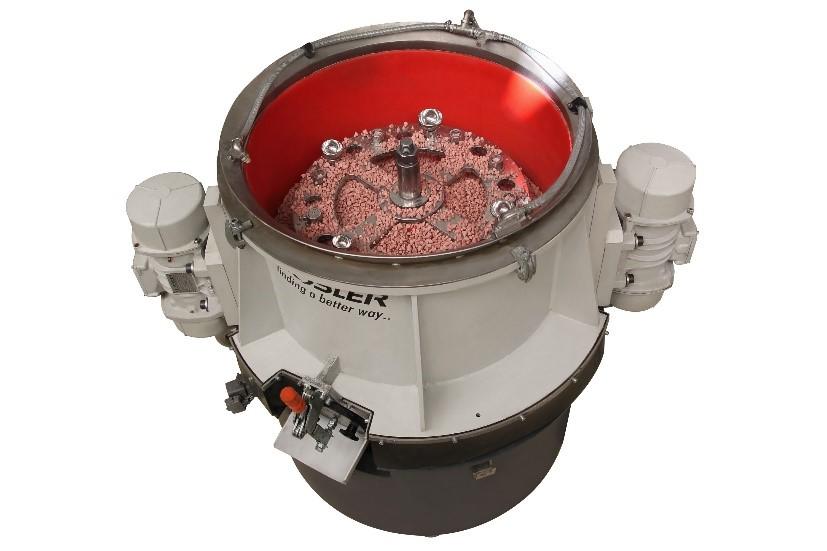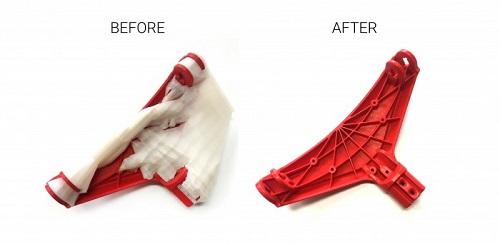- FMA
- The Fabricator
- FABTECH
- Canadian Metalworking
Our Publications
Categories
- Additive Manufacturing
- Aluminum Welding
- Arc Welding
- Assembly and Joining
- Automation and Robotics
- Bending and Forming
- Consumables
- Cutting and Weld Prep
- Electric Vehicles
- En Español
- Finishing
- Hydroforming
- Laser Cutting
- Laser Welding
- Machining
- Manufacturing Software
- Materials Handling
- Metals/Materials
- Oxyfuel Cutting
- Plasma Cutting
- Power Tools
- Punching and Other Holemaking
- Roll Forming
- Safety
- Sawing
- Shearing
- Shop Management
- Testing and Measuring
- Tube and Pipe Fabrication
- Tube and Pipe Production
- Waterjet Cutting
Industry Directory
Webcasts
Podcasts
FAB 40
Advertise
Subscribe
Account Login
Search
Postprocessing gains importance as the number of parts in 3D-printed production runs increases
A 3D-printed part isn’t complete until it goes through postprocessing—a job that some consider to be more difficult than building the part
- By Kip Hanson
- March 30, 2019
- Article
- Additive Manufacturing

Efficient postprocessing of 3D-printed parts takes on more importance as production volumes increase. Image: ProtoCAM
Let’s face it—the parts coming out of most 3D printers are … a little ugly. There are supports to remove, powder and resin to clear away, and critical surfaces and features to machine. Without these secondary operations, printed parts are of little value.
As any parts designer will tell you, complexity may be free with additive manufacturing (AM), but the postprocessing needed to make his or her latest brainchild functional and aesthetically pleasing comes at a significant cost.
“Two-thirds of our facility is dedicated to postprocessing technicians and equipment—only one-third goes to actual printing,” said Ed Graham, vice president of additive manufacturing at ProtoCAM, a service bureau in Allentown, Pa. “And of those technicians, the average tenure is 15 years. We’re very lucky in that respect, because there’s nowhere to go if you need people with these skills. For me, printing is the easier part of additive manufacturing. It’s postprocessing that’s hard.”
A Tough Row to Hoe
But what makes postprocessing so difficult, and why is it even necessary in the first place? With laser-powered printers costing more than most CNC machine tools—and often a lot more—one would think they could deliver parts ready for prime time without the need for human-powered cleaning, blasting, scraping, and sanding.
To answer those questions, it’s necessary to understand the 3D printing process. AM works as its name suggests, by gradually adding material to a workpiece, usually one paper-thin layer at a time. And just as an office building may need bracing to keep the walls and floors stable during construction, so too do many additive processes require supports in the form of lattice-like structures to keep the burgeoning workpiece from drooping or warping during its production. These supports must be removed postbuild.
The layer-by-layer build process also creates a stairstep effect on all nonhorizontal part surfaces. These layers typically require some level of smoothing once the part has left the chamber, and functional surfaces may need secondary machining. Holes, for example, often require reaming or boring; threaded parts must be tapped or thread-milled; and, depending on the size of the workpiece, its geometry, and the type of additive process used, features with dimensional specs tighter than ±0.005 inch or so will need to be finished on a CNC machining center, lathe, EDM, or grinder.
There’s also the raw material to consider. Parts pulled from a powder bed 3D printer resemble a badly baked cake, with clumps of metal or plastic wedged into its pockets and crevices, while those that emerge from the vat of a resin-based printer are often a gooey mess. Here again, all this excess powder or resin must be removed from the newborn workpiece and the leftover material reclaimed for later use.
Printed metal parts—a key reason for AM’s significant growth in recent years—must be cut away from their build plate and then heat-treated to remove the internal stresses generated during the printing process. Upon completion of the secondary processes just described, parts are often painted, anodized, or plated, just as with subtractively manufactured components.
Similarly, polymer parts can be painted or plated but are often dyed in a process that resembles coloring Easter eggs.
The Need for Speed
Fortunately, the machining and fabricating industries have been postprocessing manufactured parts for centuries, and virtually all the traditional methods used for this are equally effective on 3D-printed components. But as AM transitions from what was long a prototype-only technology to a mainstream, end-use parts manufacturing process, the challenge is scaling and automating these processes to support additive mass production.
“There’s a real shift in the industry right now,” said Graham. “Where it might be cost-effective using human labor to finish a prototype or even a couple dozen parts, we’re now seeing orders for 1,000 pieces or more. That’s why more efficient postprocessing methods are increasingly important now, because of all the emphasis recently on end-use materials, faster print times, larger build envelopes, and, ultimately, higher production volumes.”Efficient postprocessing is more than a need for speed, however. Graham said reproducibility and consistency are equally important attributes difficult to achieve with manual parts processing.
This explains ProtoCAM’s recent investment in an automated part cleaning machine from DyeMansion North America, which ProtoCAM uses to postprocess parts coming from its HP MultiJet Fusion 3D printers.
Data Driven
Similar systems are available from PostProcess Technologies Inc., Buffalo, N.Y., which offers support removal and surface finishing equipment for all 3D-printed materials and print technologies.
Lead technical trainer Andy Kottage said automated, cost-effective postprocessing depends on three elements: hardware, software, and chemistry. And each is applied according to the unique combination of part material and geometry.
“All of our solutions take these elements into account, but the necessary intelligence starts with the software,” he explained. “Additive manufacturing is a very data-driven process, and we realized early on that we could use this data to manage the chemical and mechanical energy needed to postprocess parts, simulating very closely the actions of a skilled technician.”
How does the process work? Anyone who’s driven their vehicle through a car wash would understand the PostProcess approach, except this car wash directs a precise stream of abrasives or chemicals at whatever pressure and velocity are needed to remove every stairstep, build support, and bit of powder. And most importantly to shops building parts by the hundreds or thousands, the system is designed for automated mass production.
PostProcess Tech also has a submersive technology where workpieces are allowed to float freely within a basket set inside a tank, then are exposed to ultrasonic energy, heat, and chemistry via an advanced pumping scheme that helps agitate the part and “tumbles it” within the bath for more effective exposure, Kottage said. It is primarily designed for products built with fused deposition modeling, PolyJet, stereolithography, and other polymer-based printers.

By fixturing workpieces within the bowl, Rösler’s R 150 DL-2 rotary vibrator provides thorough and predictable finishing of many 3D-printed components.
No One-stop Shopping
Bernie Kerschbaum, CEO of Rösler Metal Finishing USA, Battle Creek, Mich., said postprocessing is far from a one-size-fits-all technology.
“A lot of people come into additive manufacturing asking, ‘OK, what’s the one type of finishing method that’s right for my part?’” he said. “The problem is that there isn’t one single method, and quite often it’s not even a single-step process.”
Kerschbaum said Rösler’s approach to postprocessing isn’t all that different than the process used to mass-finish castings and forgings, injection-molded plastic parts, metal stampings, and machined components—products the German-based company has been grappling with since 1933. And as with traditionally manufactured parts, any number of methods may be employed to postprocess 3D-printed ones, based on a variety of factors.
“It doesn't really matter how the parts were made,” he said. “Whether additive or subtractive … there’s really not much more to successful postprocessing than finding the right process or combination of processes to achieve the desired result. Experience in solving surface finishing challenges and a good understanding of the entire production chain will help in finding the most cost-effective solution for any part.”
About the Author

Kip Hanson
About the Publication
- Podcasting
- Podcast:
- The Fabricator Podcast
- Published:
- 04/16/2024
- Running Time:
- 63:29
In this episode of The Fabricator Podcast, Caleb Chamberlain, co-founder and CEO of OSH Cut, discusses his company’s...
- Trending Articles
- Industry Events
16th Annual Safety Conference
- April 30 - May 1, 2024
- Elgin,
Pipe and Tube Conference
- May 21 - 22, 2024
- Omaha, NE
World-Class Roll Forming Workshop
- June 5 - 6, 2024
- Louisville, KY
Advanced Laser Application Workshop
- June 25 - 27, 2024
- Novi, MI




























